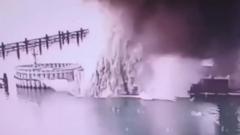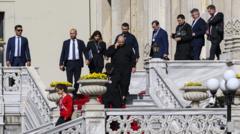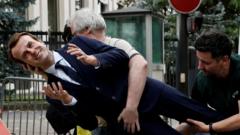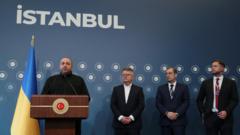Life in the Russian-occupied regions of Ukraine has become fraught with risk and fear. Citizens like Mavka, Pavlo, and Iryna share their experiences of navigating a transformed reality, as they balance the dangers of forced allegiance with subtle forms of resistance. Through secret networks and acts of defiance, they strive to preserve their Ukrainian identity while coping with the pressures of occupation.
Daily Acts of Defiance: Life Under Russian Rule in Occupied Ukraine
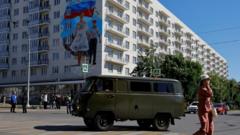
Daily Acts of Defiance: Life Under Russian Rule in Occupied Ukraine
Amid increasing repression in Russian-occupied cities, citizens in Ukraine continue to resist through small yet significant acts of defiance, hoping to maintain their identity and hope for the future.
In the heart of Russian-occupied Ukraine, residents grapple with an ever-present atmosphere of fear and repression, compelled to navigate daily dangers and struggles under foreign rule. Mavka, Pavlo, and Iryna, three Ukrainians from different cities, shared their harrowing experiences with a backdrop of silent resistance and subtle defiance against Russian authority.
Since the onset of war, approximately 20% of Ukraine is now under Russian control, with citizens facing increasing pressure to conform. Mavka, who remained in Melitopol amid the 2022 invasion, recalls how the city has transformed, with overt "Russification" strategies infiltrating every aspect of life. She notes the disturbing presence of military propaganda in schools and public spaces, where students are encouraged to adopt Russian symbols and narratives.
Pavlo, living in Mariupol—an important port city devastated by Russian forces—echoes the sentiment of feeling isolated and trapped. With ongoing pressures to gain Russian citizenship to access basic services, he reflects on the most pressing concern for residents: property. The heavy toll of war has left much of Mariupol in ruins, with locals obsessively discussing their homes and how they might reclaim their lost lives.
Meanwhile, in Crimea, a region under occupation since 2014, Iryna describes how public displays of Ukrainian identity have been effectively obliterated. Speaking Ukrainian is dangerous, and children are indoctrinated with the Russian anthem at a young age. Despite the risk, Iryna often wears her traditional vyshyvanka during private calls to remind herself and others of their cultural roots and the life they once knew.
Each of them participates in subtle acts of resistance, whether through involvement in clandestine networks like Zla Mavka or sharing messages of solidarity. Mavka runs social media accounts designed to uplift spirits and awareness among other Ukrainians, while also carrying out risky acts, like leaving pro-Ukrainian symbols in public spaces.
For these civilians, the real fear lies not just in violence from occupying forces, but in the fear of disappearing without a trace. Their resistance manifests in communal efforts to gather strength and encourage hope amidst overwhelming adversity. Mavka correctly reflects, “We are not using arms to fight, but we are here to make sure the identity of Ukrainians remains strong.”
Yet, the future remains uncertain as they watch for signs of potential negotiations that could solidify their fate. While Mavka remains hopeful for Ukrainian resistance, Pavlo recognizes the complex realities of war and ceasefires, fearing feelings of abandonment among those who have fought and suffered. In the meantime, Iryna worries for the next generation, who are growing up in hostility and conflict with little guidance toward peace.
Together, these stories illustrate the tireless spirit of those living under occupation in Ukraine, determined to uphold their identity and hope for a tomorrow where they can freely reclaim their lives.
Since the onset of war, approximately 20% of Ukraine is now under Russian control, with citizens facing increasing pressure to conform. Mavka, who remained in Melitopol amid the 2022 invasion, recalls how the city has transformed, with overt "Russification" strategies infiltrating every aspect of life. She notes the disturbing presence of military propaganda in schools and public spaces, where students are encouraged to adopt Russian symbols and narratives.
Pavlo, living in Mariupol—an important port city devastated by Russian forces—echoes the sentiment of feeling isolated and trapped. With ongoing pressures to gain Russian citizenship to access basic services, he reflects on the most pressing concern for residents: property. The heavy toll of war has left much of Mariupol in ruins, with locals obsessively discussing their homes and how they might reclaim their lost lives.
Meanwhile, in Crimea, a region under occupation since 2014, Iryna describes how public displays of Ukrainian identity have been effectively obliterated. Speaking Ukrainian is dangerous, and children are indoctrinated with the Russian anthem at a young age. Despite the risk, Iryna often wears her traditional vyshyvanka during private calls to remind herself and others of their cultural roots and the life they once knew.
Each of them participates in subtle acts of resistance, whether through involvement in clandestine networks like Zla Mavka or sharing messages of solidarity. Mavka runs social media accounts designed to uplift spirits and awareness among other Ukrainians, while also carrying out risky acts, like leaving pro-Ukrainian symbols in public spaces.
For these civilians, the real fear lies not just in violence from occupying forces, but in the fear of disappearing without a trace. Their resistance manifests in communal efforts to gather strength and encourage hope amidst overwhelming adversity. Mavka correctly reflects, “We are not using arms to fight, but we are here to make sure the identity of Ukrainians remains strong.”
Yet, the future remains uncertain as they watch for signs of potential negotiations that could solidify their fate. While Mavka remains hopeful for Ukrainian resistance, Pavlo recognizes the complex realities of war and ceasefires, fearing feelings of abandonment among those who have fought and suffered. In the meantime, Iryna worries for the next generation, who are growing up in hostility and conflict with little guidance toward peace.
Together, these stories illustrate the tireless spirit of those living under occupation in Ukraine, determined to uphold their identity and hope for a tomorrow where they can freely reclaim their lives.







